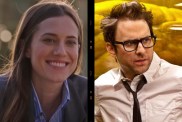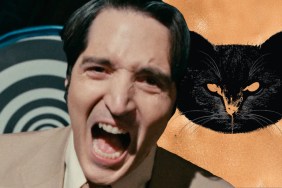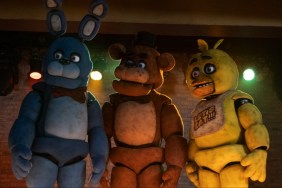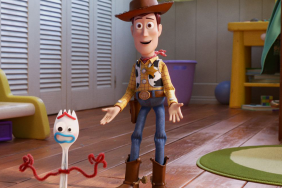If you’re looking for just the right place to throw an engagement party, you could certainly do a lot worse than The Drunken Pig, a delightfully rustic bed and breakfast right in the heart of Sonoma Valley. But don’t take our word for it. Just ask Tom and Violet, a happy couple that have chosen the Pig as the perfect place to celebrate their decision to tie the knot. Of course if, for whatever reason, this particular engagement party doesn’t work out, they can always throw another one next year. Or the year after that. Or the year after that. Or the year after that…
Welcome to the set of The Five-Year Engagement, the latest collaboration between Jason Segel and Nicholas Stoller. Just like their Forgetting Sarah Marshall, both wrote the screenplay while Stoller directs and Segel stars.
“I am obsessed with relationship and romantic comedy stuff,” Stoller explains of his return to the genre, “It’s kind of what I love. I don’t know, we were just kind of thinking about different ways to explore relationships, and I remember sitting at my desk and the words ‘Five-Year Engagement’ just popped into my head and I was just like, ‘I think that’s a movie!’ And I was also obsessed with people who are engaged or together for a long time and don’t seal the deal. I think that’s something and I think it’s an ‘our generation’ thing, you know?”
GALLERY: View new photos from the April 27 release!
Segel’s Tom has his Violet in the form of Emily Blunt and we enter the story after they’ve already started a seemingly happy relationship in San Francisco. Tom, who dreams of being a chef, has just proposed and decides that “for better or worse” should more than brace the two of them for a move to Michigan where Violet plans to attend graduate school before they exchange vows.
“[A] part of it is a couple that gets married at the beginning of the movie,” adds producer Rodney Rothman, “but doesn’t know each other yet or their relationship hasn’t been tested in certain ways. Over the course of the movie, it’s getting tested. It’s like the more information you get about someone, the harder, more complicated the decision it is to make whether you can commit your whole life to them.”
In somewhat of a reversal of the film’s narrative, the cast and crew actually have their cold Ann Arbor nights behind them. This engagement party marks their first day of shooting in California and the Sonoma Valley summer at the Beltane Ranch (which actually does offer a non-pig themed bed and breakfast) is a welcome change. There, the day begins with a scene between Blunt and an actor named Murray Miller, who plays a man showing off Sonoma property as a potential place for her wedding. Unfortunately for Violet, Miller’s character has no problem hitting on her the entire time.
“[Murray is] actually not an actor,” laughs Stoller, “He’s a writer that Rodney and I are friends with. He’s just crazily funny, especially when hitting on people.”
Take after take, Miller and Blunt stray quite a ways from the three lines of dialogue in the script, throwing out improvised lines and changing the dynamic by sometimes having the awkwardness of Miller’s advances build slowly and sometimes having them happen with over-the-top immediacy. Off camera, Stoller calls out suggestions or even full lines if he thinks repeat takes are getting stale.
“Sometimes things that are really funny on the day, when you look at them in post can feel too broad, you know?” the director says. “Sometimes not, but it’s kind of weird how that can change. And sometimes you’re not noticing a little eye movement that’s hilarious. So it all kind of gets figured out in post.”
As far as improvisation goes, this scene is nothing compared to what the cast and crew are going to spend the bulk of the day shooting. The actual engagement party calls for an assembly of many of the films’ supporting cast, including Alison Brie as Violet’s sister, Suzie Barnes, Jacki Weaver and Jim Piddock as their parents, Chris Pratt as Tom’s best friend, Alex, and David Paymer and Mimi Kennedy as Tom’s parents.
Dining outside The Drunken Pig, the two families drink to the happy couple and each actor has to present a wedding toast that, like the early scene, offers liberal doses of on-the-spot dialogue adjustments. Since the film is already targeted for an R rating, the actors are free to do and say whatever they want.
“It’s not for the ‘f—s,'” laughs Stoller of the rating, “It’s for the bad sex that we want the R. If you’re going to have a five year relationship, you need to explore that side of it Nothing makes us laugh like weird, awkward, bad sex and there’s a lot of that.”
Being outside also allows for another important element of the film. Stoller is very keen on making sure that the audience is aware of the passage of time and the bright, sunny Sonoma valley offers a staunch contrast to the freezing snow of Ann Arbor.

“‘When Harry Met Sally’ is very seasonal,” says Stoller. “‘Annie Hall,’ too. Those are both movies that take place over a long time. The characters – their dress changes, but they don’t look different, you know? Their dress changes and their hair might change a bit and they might look a little bit more sophisticated, but it’s the seasons that are changing and everyone around them is maturing. That’s what we tried to do with it.”
While there are films like these that served as inspiration, Stoller is also determined to make the ending of “Five-Year Engagement” something that doesn’t follow the cinematic norm. Because by virtue of its title, the narrative will be building towards a hypothetical wedding, there are surprises added in along the way to keep the audience uncertain if the characters will make it that far.
“What’s hardest is to do it in a new way,” the director explains. “There’s been a wedding at the end of every movie. So obviously we’re trying to avoid the clichés to try to make sure that it’s unique and that there’s an emotional payoff to it in some way.”
“Our running to the airport sequence!” Rothman laughs.
“You’re not going to believe how fast they run!” Stoller quips back.
Tom and Violet
“Nick and I sold this immediately after ‘Sarah Marshall,'” says Segel, doing an interview between takes side-by-side with Blunt. “It was before it had even come out. It was this and ‘The Muppets’ around the same time. So we’ve been writing both for the past four years. But this is the one that was sort of the truest to our evolution as a team I think. It’s more adult, I think, than ‘Sarah Marshall’ or Get Him to the Greek’ in that it explores relationships in a pretty depthful way and it’s also really, really funny, I hope.”
Because they had worked together in the past, Segel had the part of Violet written for Blunt and, throughout the casting process, he and Stoller would rewrite every part specifically for the actor that would be playing it.
“We really sat down with [Emily] and found out how she wanted to play this character and how she saw it,” he explains. “We did a hefty rewrite for her. Then we didn’t know what [Rhys Ifans’] Winton character was going to be like until we found the dude. If that had been someone else — even just the fact that he is Welsh — you can’t just ignore that as a character trait. So you do a lot of rewriting once you find the people.”
“I think you cast very specific people too,” Blunt adds. “So I feel like there is real distinction with the characters. Rhys’ character’s voice is utterly different from Alison’s or someone else. That is what I find really refreshing about the movie. Rhys put it really well. He said, ‘Every scene is just so juicy.’ The characters are so juicy because they are very specific. Some of them are larger than life but yet you feel that you have met people like that.”
Beginning the film as a happy couple, Tom and Violet spend most of the day’s shoot reacting to the horrifying things that come out of the mouths of their family and friends at the engagement party, including a musical tribute to Tom’s ex-girlfriends, performed by Pratt’s Alex, to the tune of Billy Joel’s “We Didn’t Start the Fire.”
“Our boundary is reality,” says Segel. “ We don’t try to do anything to push the limits of taste at the sacrifice of reality. The story, for as funny as it is, is very grounded. So there is never an effort to try and show how gross we can be or how far you can push any limits.”
“It’ll tonally be wrong for this movie as well,” continues Blunt. “There is so much heart in this film that it would be weird to compromise that for the sake of a gross laugh.”
That doesn’t mean that the set is wholly devoid of gross laughs. Both actors try to keep a straight face recalling particularly infamous takes that happened during filming.
“One of our actors stood up and just accidently farted,” says Segel.
“He was wearing really tight pants!” laughs Blunt. “His costume is supposed to be a guy in a midlife crisis. It’s Jim [Piddock], who is playing my dad. He stood up and let one go.”

“He had been complaining about his pants all day and how tight they were,” Segel continues, ” Then that happened. Then there was this one time where the sound guy was trying so hard not to laugh that he just continuously farted.”
“It was the guy holding the boom!” says Blunt.
“He was shaking and crying so hard trying not to laugh,” says Segel, “and was just farting the whole time. It was amazing. That was my favorite thing on set.”
On the more serious side of things, though, there’s a distinctly dramatic truth to everyday relationships that both actors are trying to bring to the surface in end.
“I think that Tom and Violet sort of strive for a perfect scenario in most cases,” says Blunt. “I think that, unfortunately, that is the thing that bounds them in some ways. It kind of holds them back. Things remain unspoken between them… And the self fulfillment dynamic shifts. One partner will be happy and then the other and that might shift. You see how that might affect them as a pair. So that is what is quite true about the movie I think.”
“[F]ive years is a long time,” adds Segel. “…[Y]ou can talk about moment to moment about whose driving the problem, but over five years that dynamic changes There is a line that Rhys says. He says something to the effect of ‘How much do you compromise your own happiness before you realize that you’ve become unhappy?’ and I think that is one of the themes of the movie as well.”









